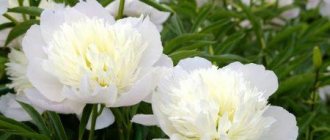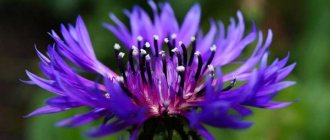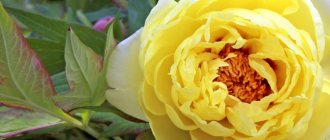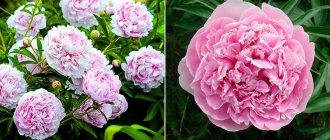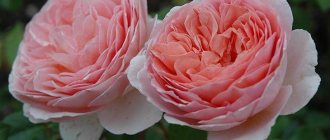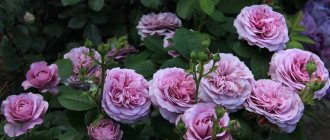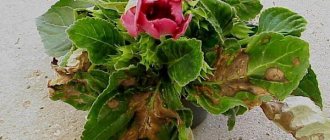General description of coral peonies
All coral species are hybrids, most of them created by American and Canadian breeders. The era of coral began in the middle of the 20th century, the best types were created by Sam Wissing, Arthur Sanders from the USA. Hybrid peonies in coral tones have strong peduncles, a lush bush with bright green, bluish foliage. By autumn the bush turns yellow or red. The flowers are densely or slightly double, sometimes simple in appearance.
The difference between coral hybrids is the gradual change in color of the petals. The bud, bright at the beginning of flowering, becomes discolored over time, the coral range is replaced by apricot, sand, beige, and yellowish shades. Many hybrids cannot maintain rich color.
Hybrids are resistant to diseases, heat and frost, and resist fungal infections better than many varieties. The bush does not crumble, does not require garter, large flowers do not bend to the ground. During the season, many shoots with buds grow, the flowers bloom gradually, providing a long flowering period.
Help: to preserve bright colors, it is recommended to plant coral varieties in places with afternoon shading.
Reviews from gardeners
Almost all gardeners note that peonies are very easy to care for. In just a few years, the plant grows, after which it can be propagated and a new one planted nearby. And, of course, everyone praises its appearance and aroma. For many, it is the peony, and not the rose, that is their favorite plant. So it’s definitely worth planting for anyone who just wants to make their plot beautiful and enjoy their luxurious and fragrant flower garden all summer long.
In the video below you can watch a review of the rare peony “Coral Sunset”.
Peonies Coral Charm and Coral Sunset
Dear flower growers! Who has Coral Charm and Coral Sunset peonies? Please share your impressions. Are they similar?
| nataly |
| Moscow |
| 01.11.2006 |
| 12:56:35 |
nataly. Sunset is not so thick and rich in color. And Charm has a thicker middle. I have still young ones, I can’t say about the full-fledged “Moscow region size”, but in the description of Coral Charma the diameter is “very large”, and Sunset is up to 20 cm. In general, if you managed to start them, you are great, these are outstanding varieties. For example, I stood in line for Coral Charm for 2 winters. Now it has become easier to get. But (this, sorry, is beside the point) while I was buying it, I grew it until it bloomed and I saw it. was somewhat disappointed. Maybe they are still really young, they have not entered into beauty. Now I like the less outstanding ones better: Cytheria, Heritage and Pink Khavayan. If you don’t have it, look for it, maybe you’ll like it too.
| larix |
| Moscow |
| 01.11.2006 |
| 15:31:54 |
Advantages of use in landscape design
Coral peonies look bright in single and group plantings. Powerful bushes and bright greenery refresh the areas, buds of rich colors are noticeable from afar. The coral tone successfully complements the red peonies.
In a group with peony you can plant:
- irises in white, yellow, brown tones;
- low coniferous crops;
- Heuchera;
- lilies;
- primrose.
The coral peony looks great against the background of a grassy lawn.
Preparing for winter
Coral Sunset is a winter-hardy hybrid. It tolerates frost well in the presence of snow cover. For successful wintering, plants carry out preparatory measures:
- Feed plants with phosphorus after flowering.
- Mulch the flowerbed in the autumn.
- Carry out autumn pruning.
Attention! In severe frosts (below -10*C), peonies should be covered with burlap, creating a kind of protective hut.
Is mulching necessary?
In the fall, after the plant enters the dormant phase, the flowerbed is mulched. The following is used as mulch:
- crushed straw;
- sawdust;
- pine needles;
- dried grass.
A 15 cm layer of mulch prevents deep freezing of the soil in winter. In early spring, the mulch is removed so that it does not interfere with the hatching of young shoots.
Bush pruning
Timely pruning significantly increases the plant’s chances of successful wintering. The entire above-ground part of the bush must be removed, excluding growth shoots above the buds, the length of which does not exceed 5 cm. All stems are shortened to “stumps” 5-10 cm long. Pruning at the root is strictly not recommended - this can injure the root system.
Other trimming features:
- early pruning can disrupt the process of photosynthesis and weaken the plant;
- the optimal time for pruning is late autumn with consistently cold weather (in the middle zone this period occurs in the first half of November, in northern latitudes - the end of October);
- the condition of the plant (the presence of diseases or pest attacks) should not affect the timing of pruning.
The most beautiful and best varieties
Coral-colored peonies were obtained by interspecific crossing. The result is a variety of impressive hybrids that have earned the love of gardeners around the world.
Beach
The peony blooms in early spring, the bush is up to a meter tall, and 3 or more buds are formed on strong stems. Semi-double flowers have a soft coral tint when blooming and become peach over time. The open bud reaches 15-18 centimeters in diameter, the core glows brightly yellow. At the same time, there are buds of different colors on the bush.
The Coral Beach variety is unpretentious, easily tolerates winter, and looks great in the garden and in a bouquet.
Cora Louis
ITO-hybrid of medium flowering period. Petals are white, white-pink or slightly white-lilac. The base of the petals is purple-lavender. The light aroma adds additional charm to the peony. The stems are strong, stable, the foliage is dark green, openwork.
Queen
Dense, densely packed double flowers have a complex color - the petals are white, soft pink, cream, with lilac strokes inside. The foliage is small, the bush is up to 80 centimeters. Belongs to late varieties. The main highlight is the thick, spicy aroma.
Magic
The early variety is one of the first to bloom in April. The petals are arranged in 3 rows, the flower is semi-double. The petals are a very bright coral red color with a yellow center. Flowers glowing with scarlet-coral light look spectacular against the background of light green foliage. The main difference is that the brightness is maintained throughout the flowering period; the petals do not discolor even in the sun. There is no scent, peony is for those who like flowers without scent.
Pink Hawaiian
A spectacular coral pink flower, bright and sparkling like the nature of Hawaii. Semi-double form, flower diameter – 19 centimeters. Early milky-flowering variety. Famous for its abundant flowering and frost resistance. The flower stalks rise 90 centimeters, the herbaceous bush is strong and lush.
The Pink Hawaiian variety received a gold medal in the prestigious category “For Landscape Merit” in 2000.
Sunset
A pink-coral flower with a bright yellow core is an interspecific hybrid selected by Wissing. Cup-shaped head, semi-double appearance. The bushes are powerful, but compact; flower stalks rise up to 110 centimeters. One of the most popular hybrids of the coral group. Peony Sunset has received many awards for its beauty, unpretentiousness and ease of care.
See also
Description of the best varieties of reticulated irises (Denford), planting and care, propagation
Read
Supreme
The mid-early hybrid Supreme is classified as a rare variety. The salmon pink flowers have a distinct coral tone, which is highlighted by a yellow center. At the end of flowering, the petals acquire a yellow-beige hue with a pearlescent tint. The tall bush does not require support and remains decorative until autumn.
Topeka
Lush, double bomb-shaped peonies bloom in red-pink color, gradually acquiring a coral shade. Diameter – 17 centimeters. The bush is low (70 centimeters) with openwork, dark foliage. An additional bonus is a light and unobtrusive musky scent.
Fey
Semi-double flowers with large, loose petals. The color of the bud is coral-pink, the petals almost do not fade in the sun and remain bright throughout the flowering period. The Fay variety grows up to 3 buds on a peduncle; the flowers are especially beautiful on an adult plant.
Charm
Coral Charm fully lives up to its name - cup-shaped semi-double flowers with wide petals in a coral shade look lovely. Gradually the ends of the petals become lighter, the middle looks brighter. Flowering ends in milky tones.
The bush is strewn with buds of different flowers, which look colorful against the background of dark green tapered leaves.
En gold
A bright hybrid with a simple flower shape, petals grow in 2 rows. Coral-orange, shining petals surround sparkling gold stamens. The flower resembles a thicket, does not fade, and retains its contrasting color until the end. The bush is tall and strong; there is no need to tie it up.
Walter Mains
Peonies of the Walter Maines variety often become favorites at the most prestigious flower exhibitions. This flower has earned universal recognition thanks to its brilliant dark red inflorescences with a light chocolate tint and red-cream stamens. Plant these peonies in your garden and everyone around will admire their elegant luxury!
| Purpose | Class | Stem height | Flowering time |
| Japanese | 80 cm | Early-middle |
We hope our selection will inspire you to plant some unusual peonies. These do not necessarily have to be varieties from our list. We have presented you with only 10 plants, but there are many more amazing and very beautiful flowers in the Peony family.
Rules of agricultural technology and plant care
Coral peonies are long-lived, growing in one place for 20 years or more without losing their decorative properties. Flowering begins at 2-3 years; on an adult plant, the flowers are larger, brighter, and more consistent with the varietal characteristics.
Features of agricultural technology:
- a bush grown for flowering does not need to be replanted;
- To regularly obtain planting material, the peony is replanted every 3-4 years.
The long lifespan of peony makes site selection and soil preparation especially important. Care will ensure comfortable conditions, a set of green mass and abundant formation of buds.
Peony planting procedure step by step
For planting perennial peonies, sunny places are suitable, where slight shading is possible in the afternoon. The crop should not be planted near houses and other buildings. Plants with a powerful crown and root system can compete with peony, taking away light and nutrients. Bushes protect from drafts.
Experienced gardeners recommend preparing the soil a year before planting. Deep plowing, humus, nitrogen, potassium, and phosphorus fertilizers are required. Planting is carried out depending on the climate in late August-early September.
Advice: before planting, the seedling is inspected - dead and damaged areas are cut off, the wounds are treated with a solution of potassium permanganate, and kept in growth stimulants (Kornevin, Heteroauxin).
How to plant correctly:
- We prepare a hole measuring 50-60 centimeters in all directions.
- The bottom of the pit is loosened to the depth of a shovel, and a drainage layer (10-15 centimeters) is added.
- Fill half or a third with nutritious soil consisting of humus, soil, peat. Superphosphate and potassium chloride are added. On acidic soils (pH less than 6.5), bone meal is added.
- The seedling is placed on a poured layer of soil vertically or at a slight angle so that the buds are in the ground. Carefully straighten the roots. It is important to install the peony correctly in the hole; on heavy soils the buds are buried by 4-5 centimeters, on light soils by 5-6 centimeters. If the peony is insufficiently or excessively deepened, it will not bloom and will suffer from frost.
- Fill the hole with nutritious soil, level the position of the seedling (raise or lower it if necessary, remembering to deepen it by 4-6 centimeters). Compact the soil with your palms.
- Make a circle for watering, carefully pour in 5-10 liters of water, focusing on the moisture content of the soil.
If the soil settles, add more from above. Mulch with organic matter in a layer of 10 centimeters. Water several liters every 5-6 days.
Watering and fertilizing the flower
The bushes require abundant watering at the beginning of the formation of buds, during flowering and during the formation of renewal buds in July. Peonies are watered once a week with warm water in a volume of 8-10 liters per adult plant if the weather is dry. During the rainy season, water less often and in smaller portions.
Mulching and loosening
The area around peonies is regularly loosened to provide oxygen access and protect the root from rot. After loosening, the root circle is covered with a layer of sawdust and pine needles to retain moisture and protect from overheating.
Trimming
Coral peonies require several types of pruning:
- The flower heads that remain on the bush are cut off when they have completely dropped their petals and begun to dry out. Protruding dry tops spoil the decorative appearance of a lush green bush. Let us remind you that coral hybrids do not reproduce by seeds; there is no need to wait for the capsule to ripen.
- During the summer season, the peony is regularly inspected and damaged and broken stems are cut out. This will protect the plant from the spread of diseases and pests. Cut stems and foliage are removed from the site.
See also
Why do irises have only leaves and do not bloom, what to do and how to eliminate the causes
Read
The bush should fade naturally. During the summer-autumn growing season after flowering, it accumulates strength for the next year. The bush is cut at the root (2-3 centimeters are left) in winter, when the stems turn yellow and dry, and frost is approaching.
Preventative treatment
With excess moisture, peonies suffer from various types of rot. It can be detected by wilting of stems and the appearance of spots on foliage and flowers. Rhizome rotting is more difficult to detect. In spring and autumn, the soil is treated prophylactically with Bordeaux mixture and fungicide solutions.
In rainy seasons, a Glyokladin tablet is slightly buried in the soil near the peony to combat the fungus in the soil, and the bush is sprayed with solutions of biofungicides (Gamair, Alirin-B). If pests appear on the site, the peony is treated with insecticides.
Preparing for winter
Part of pre-winter preparation is bush pruning. It is carried out on the eve of frost. Coral hybrids demonstrate high frost resistance; in most cases, it is enough to mulch the soil in winter. Need shelter:
- young bushes planted this season;
- weakened plants that grew and bloomed poorly, suffered from diseases or pests.
After mulching, the bushes are covered with boxes or spruce branches. The covering material should be removed in early spring, when the threat of severe frost has passed.
How to plant?
Peony shoots are planted in late summer - early autumn. The landing is carried out according to the following scheme:
- dig a hole 60 cm deep,
- place the seedling and carefully cover it with soil, avoiding the formation of air pockets,
- trample the soil and water generously.
Important! If, when placing the seedling, the buds are above the soil surface, the peony will bloom in the first year. And if they end up underground, flowering will occur only in the second year.
What to do if the peony does not bloom?
Let's look at the most common mistakes in planting and caring for peonies that prevent the crop from blooming:
- unfavorable place for planting (shade, more powerful plants, buildings, high groundwater nearby) - needs to be replanted;
- the old bush has exhausted its life resource - divide and plant again;
- incorrect division - too few roots to grow greenery and buds;
- planting too deep or shallow - dig up the bush and replant it;
- kidneys are damaged by frost - you will have to wait until next year;
- excessive use of nitrogen fertilizers - the bush grows green mass, there are no buds - fertilize with potassium and phosphorus fertilizers;
- poor care (lack of fertilizing, poor watering) in the previous year - the peony did not have enough strength to set buds;
- The green part was cut off early, the bush did not stock up on nutrients.
Peonies also do not produce buds when the soil is highly acidic (a pH greater than 6 is required) or the bush is damaged by fungal infections.
Peculiarities
Regardless of the variety, all coral peonies have common characteristics:
- Large bush size . Most varieties grow up to 70–90 cm. The plants have a spreading crown and a well-branched root system.
- Frost resistance . These peonies feel great in the Russian climate and successfully winter when the thermometer drops to –40ºC.
- Moderate solarization and watering needs . Peonies grow well in open areas that get full sun most of the day. However, excessive solar activity can be detrimental to them. The soil in the flowerbed should always be moist. At the same time, stagnation of water or flooding of the area after the snow melts can provoke diseases of the root system.
- Drained neutral soil . Peonies do not like acidic soil. The maximum permissible pH level for normal growing season is 7.0 (recommended - 6.5). The soil should allow moisture to pass through and contain a small amount of clay. On heavy soils, peony roots develop poorly, which affects the size of the plant and the quality of flowering.
Reproduction methods
Coral peonies are not propagated by seeds. Of the vegetative methods, the most accessible and win-win is dividing the bush. The peony is ready for propagation at 4-5 years. Division rules:
- time - early spring before the growing season, early autumn (late August-September);
- the bush is dug up, freed from the soil, and allowed to rest so that it is easier to divide;
- the hard rhizome is sawed with a hacksaw, forming divisions with 2-3 buds;
- The sections are rubbed with charcoal, and the seedlings are disinfected with a solution of potassium permanganate.
Plant in prepared holes and water. When planting in spring and in warm weather, shade from the sun. Peony lovers recommend propagating the bush in the fall, waiting until the summer heat ends. The most difficult thing is to separate the hard root; it is kept for up to a day to make it easier to saw.
Important: small rhizome divisions are more viable than large ones. The peony grows faster and forms a powerful root system.
Planting by seeds
Most gardeners do not use seeds to propagate Paeonia Pink Hawaiian Coral.
Seedlings obtained after seed germination do not have the qualities endowed with the parent plants. But if you still have the task of growing a seedling from seeds that have a beautiful name, consonant with the Pacific coral island, then first you need to purchase high-quality seeds of these peonies and check their germination. Then the seeds are treated with a fungicide or simple pale pink potassium permanganate, washed in running water, dried and placed in flower pots with a soil substrate of neutral acidity, buried 5 cm. This is done in August-September, approximately 30 days before the onset of cold weather. Pots are buried in the garden for the winter. The seeds need to stay in the cold, preferably under snow or mulch, for at least 2 months. In the spring, with the onset of warmth, peony seeds should germinate.
Note! In autumn, seedlings are transplanted from flower pots to a flower bed.
Pest diseases
The most common diseases of peonies are gray rot, powdery mildew and cladosporiosis. Quite often, plants are attacked by aphids and ants.
Note! Ants and aphids are especially dangerous for peonies. They suck the juice from the buds, which leads to their drying out and lack of flowering.
Inflorescences suffer from diseases
At the first signs of deterioration in the appearance of the flower, it is necessary to spray not only the diseased plant, but also all neighboring ones. Treatment should also be carried out for prevention.
Peony Coral Supreme is a wonderful representative of the world of flowers. This rare and exquisite variety will not only decorate the garden, but also fill it with a magical aroma. The plant requires the most ordinary care, but its flowering will definitely delight flower lovers.
